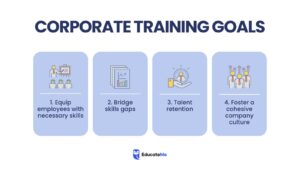Corporate Training: Shaping the Future of a Smarter Workforce
In today’s rapidly evolving business landscape, corporate training is no longer a luxury — it’s a necessity. The marketplace is more dynamic, digital, and demanding than ever before. Companies that invest in structured, impactful training are not just enhancing employee skills; they’re cultivating resilience, innovation, and a culture of continuous growth.
Yet, corporate training is often misunderstood. Many see it as a checkbox — a one-time seminar, a couple of e-learning modules, or a compliance course. In reality, true corporate training goes deeper. It empowers individuals to evolve, aligns employees with company vision, and bridges the gap between knowledge and performance.
Beyond Learning: The Purpose of Corporate Training
The core of corporate training is transformation. It’s about developing competencies that aren’t just technical, but behavioral and strategic. From leadership development to emotional intelligence, from change management to ethical communication — training shapes not only what employees do, but how they do it.
Effective training creates confident professionals who can adapt, collaborate, and contribute meaningfully. In a hybrid and increasingly remote environment, where digital fluency is essential, training also reinforces critical netiquette — the respectful and responsible use of communication technologies in the workplace. Just as we learned in school how to behave in a classroom, employees need clear guidance on how to show up in virtual meetings, respond to emails, and contribute to team chats with professionalism.

The Business Case: ROI That Matters
Companies that invest in corporate training enjoy a more agile workforce. According to a LinkedIn Workplace Learning Report, 94% of employees say they would stay at a company longer if it invested in their learning. That’s a powerful insight for businesses struggling with retention and engagement.
Training also reduces costly errors, improves customer service, and accelerates innovation. When employees understand the “why” behind their roles and responsibilities, they become proactive problem-solvers instead of passive task performers.
Moreover, training supports diversity and inclusion. Sessions on unconscious bias, inclusive leadership, and cross-cultural communication foster a workplace that’s not just productive, but respectful and equitable. These outcomes are not soft metrics — they are business imperatives.
What Makes Training Effective?
Not all training is created equal. A PowerPoint presentation or one-size-fits-all webinar won’t spark long-term change. Effective corporate training is:
- Purpose-driven: Every session should align with organizational goals and employee needs.
- Interactive: Learners should be active participants, not passive viewers.
- Contextual: Real-life scenarios and case studies make learning relevant and relatable.
- Feedback-oriented: Ongoing feedback and follow-up reinforce knowledge and encourage growth.
- Tech-savvy: In the digital age, tools like learning management systems (LMS), mobile learning, and gamification drive engagement.
Companies must also personalize training paths. An early-career professional has different needs than a senior leader. By mapping learning journeys across roles and experience levels, organizations can ensure that every employee receives the right learning at the right time.
Culture: The Invisible Teacher
A company’s culture plays a silent yet powerful role in training effectiveness. If the organizational mindset doesn’t value learning, even the best training programs will fall flat. Leaders must lead by example, actively participating in learning initiatives and reinforcing key messages in day-to-day operations.
Additionally, creating a safe space for learning — where questions are encouraged, and mistakes are seen as part of growth — builds trust and curiosity. This is where internal communication, manager involvement, and HR alignment become essential.

Training as a Strategy, Not an Event
The best organizations treat training as an ongoing strategy, not a quarterly event. It’s not about ticking a box, but about embedding a learning mindset into the DNA of the organization. Whether through mentorship programs, microlearning platforms, cross-functional projects, or leadership bootcamps — training should evolve with the business.
In an age where AI, automation, and globalization are redefining jobs, reskilling and upskilling are vital for survival. Corporate training is not just an HR initiative — it’s a leadership responsibility.
Final Thoughts
Corporate training is more than development — it’s empowerment. It equips individuals to face uncertainty with confidence, solve problems with creativity, and collaborate with empathy. In doing so, it transforms workplaces into learning ecosystems, where people and performance grow hand in hand.
Investing in training is not just good for employees — it’s good for business. Because when we train people well, we don’t just change skillsets; we change mindsets. And that’s how future-ready organizations are built — one training session at a time.
“Corporate training isn’t an expense — it’s an investment in people, purpose, and performance. When you train minds, you transform businesses.”
— Inspired by the leadership principles of Peter Drucker





Leave a Reply